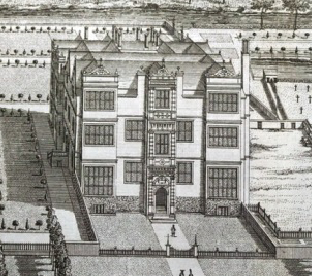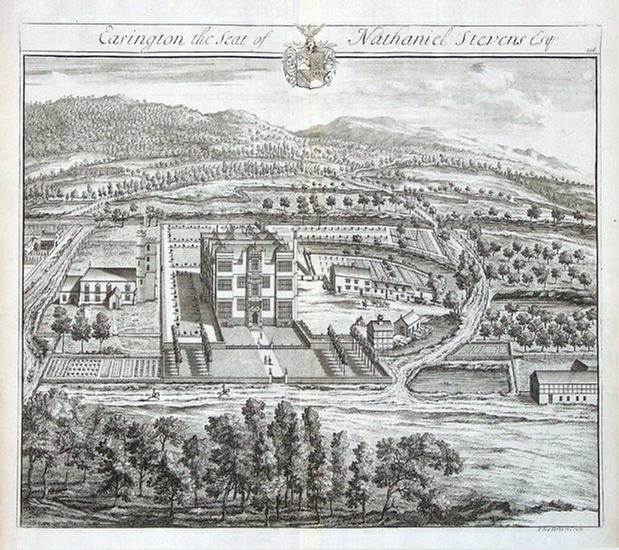

Eastington’s Lost Manor House
Stephen Mills
In the previous issue of the ECN, we heard about the possible traces of an early manor house (at Alkerton) that once stood where Alkerton House was later built. This in turn was swept away by the development of Swallowcroft. But this is about a different manor house, also long gone.
This was the manor house that was built in Churchend, next to where the church now stands. Like Alkerton manor, this also replaced an earlier structure. Again, as with Alkerton, this was also surrounded by a moat.
Some historians suggest that this site at Churchend could have been the earliest part of the village to be settled permanently - this may have been by the 11th century or even earlier. Of course, we have no details of this although by the 1300s, a manor house was mentioned as standing adjacent to the west end of the church.
In 1409, it was recorded as being surrounded by a moat with a wall inside. Entrance was gained via a drawbridge “and great gate with a chamber above”. Other parts of the house comprised a chapel on the north side, a great chamber on the west, and a kitchen.
However, this earlier house was eventually replaced by a new one, the subject of this article. This was a large structure built around 1578 by Edward Stephens, Lord of the Manor.
The new manor house was of three storeys and built of dressed local stone.

As can be seen from the engraving, it was lit by numerous large rectangular windows, an expensive luxury for the time.
It also had a front porch that extended the full height of the building. This accommodated the front doorway that was flanked “with rusticated pilasters and entablature and windows on the two upper floors flanked by similar pilasters”.
A century later, it was noted that to keep the place warm, it had no less than 19 fireplaces! Perhaps surprisingly, in the early 1700s, part of the moat still survived on the west side of the house. It’s quite possible that this was being used as a fish pond, breeding fish for the Lord of the Manor’s table.
There was also a dovecote close by, used to provide birds and eggs to the household. Eventually, in the early 18th century, the Stephens family deserted Eastington, moving to Chavenage House near Horsley.
The Eastington manor house appears to have then been let to tenant farmers and for many years, it was recorded as a farm house.
This period doesn’t seem to have been too kind to the old place, as it was said to have gradually decayed and gone to ruin. In 1778, the end came and it was finally demolished. Since then, the final traces of the moat have disappeared, as have the gardens, dovecote and various out buildings. However, the detached stone-built range to the right survives as cottages.
The present road that runs in front of the church once formed the private drive to the manor house. Churched itself was linked to the main road into the village by a lane that once ran from the corner of the churchyard and linked up close to where the driveway to Eastington Park now is. It is thought to have been known as Church Way.
When Eastington Park was built by Henry Hicks around 1815, Church Way was closed off, with the manor’s former driveway now becoming the road to Churchend. So, many of us regularly drive or walk along the road that once took important visitors to the main entrance of the manor house, something we wouldn’t have been able to do a few centuries ago!
Like a lot of land, mills and other buildings in the village, in 1806, Henry Hicks bought the rights to the manor from the Stephens family, thereby assuming the role of lord of the manor.

This engraving of 1712 shows the Stephen’s manor house, adjacent to the church at Churchend.
It was engraved by Johannes Kip, a Dutch draftsman, engraver and print dealer originally from Amsterdam. Along with his business partner, Leonard Knyff, he specialised in making engraved views of English country houses. There are few in this part of the world that he didn’t draw. His speciality was this type of birds-eye view, although he did sometimes seem to take a few liberties with scale and background. According to his engraving of Eastington Manor, then the seat of Nathanial Stephens (‘Stevens’), the house dwarfed the church and its position in the landscape looks a bit suspicious! Nonetheless, his detailed views of the buildings themselves provide a fascinating snapshot of times long gone.
At least the Stephen family wouldn’t have struggled to park their cars in front of the house at school times!




Eastington Community News Magazine. Community news for and by the people of Eastington, Gloucestershire
| Parish Council Newsletter |
| Council Notices |
| District council Newsletter |
| Village Agent |
| Nbhd Development plan(NDP) |
| Eastington Primary School |
| Playgroup |
| For the Little Ones |
| St Michaels Anglican Church |
| Eastington Methodist Church |
| Alkerton Ragers |
| Community Land Trust |
| E.C.Orchard Group. |
| Jolly Joggers |
| PROWD (footpaths) |
| Slimming World |
| Snakey Park |
| Our Lost Manor House |
| Interview at the Badger |
| Flower and Veg Show |
| Citizens Advice Bureau |
| Eastington Horse Show |
| Other Events |
| Frampton Bowls Club |
| Gloucestershire Outdoor Group |
| Advertisements |